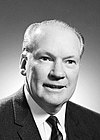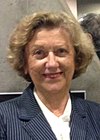Division of Grayndler
| Grayndler Australian House of Representatives Division | |
|---|---|
 Division of Grayndler in New South Wales, as of the 2016 federal election. | |
| Created | 1949 |
| MP | Anthony Albanese |
| Party | Labor |
| Namesake | Edward Grayndler |
| Electors | 109,645 (2019) |
| Area | 32 km2 (12.4 sq mi) |
| Demographic | Inner Metropolitan |
The Division of Grayndler is an Australian electoral division in the state of New South Wales.
History[]
The division was created in 1949 and is named for Edward Grayndler (1867–1943), a Member of the New South Wales Legislative Council from 1921 to 1934 and 1936 to 1943, and General Secretary of the Australian Workers' Union from 1912 to 1941. The division was originally a solidly working-class area, although migration and gentrification have since radically changed its demography. Despite the demographic changes, it has been held by the Australian Labor Party for its entire existence; the Liberals have only once received 40 percent of the two-party vote. Grayndler also has a very high percentage of Australian Greens voters with 23 percent of the primary vote at the 2013 election. At the 2010 election, the two-party-preferred vote was between Labor and the Greens, one of only 3 in Australia (the others being Batman and the Greens held Melbourne).
Its most prominent members have been Fred Daly, who was a minister in the Whitlam government, Leo McLeay, who was Speaker of the House 1989–93, and Anthony Albanese. Albanese, a minister in the Rudd and Gillard governments, Deputy Prime Minister for three months in 2013, and currently the leader of the Australian Labor Party and Opposition Leader.
Daly was succeeded by Gough Whitlam's son, Tony Whitlam, who served only one term before the neighbouring Division of Lang was abolished, and lost preselection to Frank Stewart, the last member for Lang. Stewart himself retired in 1979 and handed the seat to McLeay.
When Transport Minister Graham Richardson was briefly forced out of cabinet due to the Marshall Islands affair before the 1993 election, left-wing power-broker Anthony Albanese arranged for fellow left-winger Jeannette McHugh to be promoted to the ministry. McHugh's seat of Phillip had been abolished, and she transferred to Grayndler. Since being a minister entitled McHugh to a seat, McLeay was forced to transfer to Watson. McHugh retired in 1996 and handed the seat to Albanese,[1] who still holds it today.
Boundaries[]
At 32 square kilometres (12 sq mi), it is Australia's smallest electorate,[2] located in the inner-southern Sydney metropolitan area, including parts of the inner-west. The electorate includes the suburbs of Balmain, Balmain East, Birchgrove, Dobroyd Point, Enmore, Haberfield, Leichhardt, Lewisham, Lilyfield, Petersham, Rodd Island, Rozelle, and Sydenham; as well as parts of Annandale, Ashfield, Camperdown, Canterbury, Cockatoo Island, Drummoyne, Dulwich Hill, Hurlstone Park, Macdonaldtown, Marrickville, Newtown, Spectacle Island, St Peters, Stanmore and Summer Hill.
Members[]
| Image | Member | Party | Term | Notes | |
|---|---|---|---|---|---|

|
Fred Daly (1912–1995) |
Labor | 10 December 1949 – 11 November 1975 |
Previously held the Division of Martin. Served as minister under Whitlam. Retired | |
| Tony Whitlam (1944–) |
Labor | 13 December 1975 – 10 December 1977 |
Lost preselection. Failed to win the Division of St George | ||

|
Frank Stewart (1923–1979) |
Labor | 10 December 1977 – 16 April 1979 |
Previously held the Division of Lang. Died in office | |
| Leo McLeay (1945–) |
Labor | 23 June 1979 – 13 March 1993 |
Served as Speaker during the Hawke and Keating Governments. Transferred to the Division of Watson | ||

|
Jeannette McHugh (1934–) |
Labor | 13 March 1993 – 29 January 1996 |
Previously held the Division of Phillip. Served as minister under Keating. Retired | |

|
Anthony Albanese (1963–) |
Labor | 2 March 1996 – present |
Served as minister under Rudd and Gillard. Served as Deputy Prime Minister under Rudd. Incumbent. Currently the Opposition Leader |
Election results[]
| Party | Candidate | Votes | % | ±% | |
|---|---|---|---|---|---|
| Labor | Anthony Albanese | 48,728 | 50.86 | +4.79 | |
| Greens | Jim Casey | 21,607 | 22.55 | +0.31 | |
| Liberal | Derek Henderson | 20,846 | 21.76 | −1.55 | |
| Science | Majella Morello | 2,613 | 2.73 | +1.41 | |
| United Australia | Paris King-Orsborn | 1,155 | 1.21 | +1.21 | |
| Christian Democrats | Gui Dong Cao | 865 | 0.90 | −0.33 | |
| Total formal votes | 95,814 | 95.75 | +2.48 | ||
| Informal votes | 4,258 | 4.25 | −2.48 | ||
| Turnout | 100,072 | 91.33 | +2.05 | ||
| Two-party-preferred result | |||||
| Labor | Anthony Albanese | 70,739 | 73.83 | +1.47 | |
| Liberal | Derek Henderson | 25,075 | 26.17 | −1.47 | |
| Two-candidate-preferred result | |||||
| Labor | Anthony Albanese | 63,529 | 66.30 | +0.48 | |
| Greens | Jim Casey | 32,285 | 33.70 | −0.48 | |
| Labor hold | Swing | +0.48 | |||
References[]
- ^ "Grayndler Electorate Profile". 2004 Federal Election. Australian Broadcasting Corporation. 2004.
- ^ "Grayndler - Australia Votes | Federal Election 2016 (Australian Broadcasting Corporation)".
- ^ Grayndler, NSW, Tally Room 2019, Australian Electoral Commission.
External links[]
- Electoral divisions of Australia
- Constituencies established in 1949
- 1949 establishments in Australia
